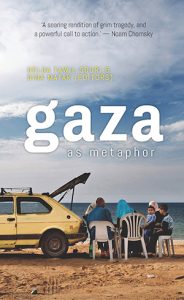Gaza as Metaphor

Editor(s): Helga Tawil-Souri & Dina Matar
Author(s): Helga Tawil-Souri, Dina Matar, Haidar Eid, Said Shehadeh, Pierre Krähenbühl, Mouin Rabbani, Naim Al Khatib, Khaled Hroub, Jehad Abusalim, Ilana Feldman, Salman Abu Sitta, Glenn Bowman, Selma Dabbagh, Ramzy Baroud, Atef Alshaer, Ilan Pappé, Darryl Li, Ariella Azoulay, Nimer Sultany, Sara Roy, Sherene Seikaly
Publisher: Hurst Publisher
Year of Publication: 2019
Print Length: 288 pages
Genre: Non-Fiction / Essay, History, Journalism, Philosophy, Political Science, Social Science
Area: Gaza, Palestine, Middle East, The Levant
Topic: Palestine, Concentration-Place, Occupation, Zionism, Imperialism, Culture & Society, Language & Literature, Linguistic, Lived Experience, Hope, Grief, Torture, Resistance, Community, Creativity, Independence & Liberation, Decolonization & Anti-Colonization, Dehumanization, Violence & Mass Violence, War, Wellbeing, Research, Equity & Fairness, Freedom, Ethnic Cleansing, Refugees & Forced Migration, Humanity, Identity, Invention, Sanctuary, Social Justice, Solidarity, Politics & Power, Ethics, Archive; Memory, Remembering and Forgetting
A unique multi-perspective take on the real and symbolic significance of this war-torn exclave — cultural and emotional as well as political.
Open-air Prison, Terror, Resistance, Occupation, Siege, Trauma: irrespective of when, where, and to whom the word is uttered, ‘Gaza’ immediately evokes an abundance of metaphors. Similarly, a host of metaphors also recall Gaza: Crisis, Exception, Refugees, Destitution, Tunnels, Persistence.
This book brings together journalists, writers, doctors, academics and others, who use metaphor to record and historicise Gaza, to contextualise its everyday realities, interrogate its representations and provide an understanding of its real and symbolic significance.
Offering perspectives from residents and observers, these essays touch on life and survival, the making of the Gaza Strip and its increasing isolation, the discursive and visual tools that have often obscured the real Gaza, and explore what Gaza contributes to our understanding of exception, inequality, dispossession, bio-politics, necro-power and other terms which we rely on to make sense of our world.
The contributors reveal the manner of Gaza’s historical and spatial creation, to show that Gaza is more than simply a metaphor for far-away humanitarian disaster, or a location of incomprehensible violence — it is above all an inseparable part of Palestine’s past, present, and future, and of the condition of dispossession.
Table of Contents
Introduction by Helga Tawil-Souri and Dina Matar
Section 1: Living Gaza
1. Gaza as Larger Than Life – Helga Tawil-Souri
2. Diary July 20, 2014 / Signposts on the Road to Liberation – Haidar Eid
3. Ghazeh el Sumud: Confronting Israeli Mass Torture – Said Shehadeh
4. Gaza as a Metaphor for Unsustainability – Pierre Krähenbühl
5. Israel Mows the Lawn – Mouin Rabbani
6. On War and Shit – Naim Al Khatib
Section 2: Placing Gaza
1. Tunnels: Love, Lions and … Absurdities – Khaled Hroub
2. From Fence to Fence: Retelling Gaza’s Story – Jehad Abusalim
3. Gaza: Isolation – Ilana Feldman
4. Gaza Strip: The Lessons of History – Salman Abu Sitta
5. Gaza: Encystation – Glenn Bowman
Section 3: Narrating Gaza
1. Inventing Gaza – Selma Dabbagh
2. Fighting Another Day: Gaza’s Unrelenting Resistance – Ramzy Baroud
3. In the company of Frantz Fanon: The Israeli Wars and the National Culture of Gaza – Atef Alshaer
4. Can the Pen be Mightier than the Sword? Permission to Narrate Gaza – Ilan Pappé
5. Gaza: Image Normalization – Dina Matar
Section 4: Thinking Gaza
1. Gaza at the Frontiers of Zionism – Darryl Li
2. Concentration-Place – Ariella Azoulay
3. Repetition – Nimer Sultany
4. Gaza: No Se Puede Mirar – One Cannot Look, A Brief Reflection – Sara Roy
5. Gaza as Archive – Sherene Seikaly

Helga Tawil-Souri is an Associate Professor of Media, Culture, and Communication; Associate Professor of Middle East and Islamic Studies; and Director of Graduate Studies in New York University Steinhardt. She works on issues to do with technology, media, culture, territory and politics in the Middle East, with a particular focus on Palestine-Israel.
Her work seeks to challenge the notion of an open and borderless world by looking at how technologies and their infrastructures — such as cell phones and the internet — impose new forms of borders and controls and work in explicitly territorial and political ways. She is equally interested in thinking about how spaces and ‘things’ that are overtly territorial and political — borders, checkpoints, and identification cards, for example — themselves function in cultural ways. Most recently, Helga has been experimenting with visual forms of expression and especially collage.
Source: https://steinhardt.nyu.edu/people/helga-tawil-souri
More from Helga Tawil-Souri in this library, click here.

Dina Matar is a Professor of Political Communication and Arab Media at the Centre for Global Media and Communication at SOAS, University of London. She has conducted research in the Arab World, particularly Palestine, Jordan, Lebanon and Syria. Before joining academia, she worked as a foreign correspondent covering the Middle East and then an editor working on the Middle East, Europe and Africa. Her primary research interest is in the intersection of communication and politics with a focus on the marginal and the oppressed as well as the relationship between structure and power in the Middle East.
Source: https://www.soas.ac.uk/about/dina-matar
More from Dina Matar in this library, click here.
